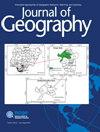The Fracking Debate: The Risks, Benefits, and Uncertainties of the Shale Revolution
IF 1.8
3区 地球科学
Q1 GEOGRAPHY
引用次数: 0
Abstract
Teaching human-environment relations inevitably involves exploring politically charged topics, such as sustainable energy futures. The problem becomes even more challenging in rural community classrooms where most community members are directly or indirectly associated with energy development. Some teachers may feel lost or apprehensive to broach such subjects, but resources exist to facilitate discussion. Daniel Raimi’s (2018) The fracking debate: The risks, benefits, and uncertainties of the Shale Revolution, provides a thorough description of contemporary oil and natural gas recovery through hydraulic fracturing (fracking), the process of pumping water, sand, and chemicals into the ground to break up underlying geology and access deposits of natural gas and oil. The book takes readers through a basic introduction to fracking, followed by the debates associated with the activity. It discusses the impact of fracking on the Unites States’ goal to achieve energy independence, along with the practice’s impact on local communities and multinational markets. Raimi concludes with thoughts on the environmental volatility of shale production, the dynamic politics of fracking, and the mixed blessings that oil and gas industries bring to rural communities. The aim of this book is to provide readers a better understanding of risks, benefits, and uncertainties associated with shale technology. Raimi begins the book by presenting the big picture overview of shale development in the US. He presents a strong argument corroborated with evidence for the precautionary principle, an idea advocating governments, businesses, and individuals take measures to prevent environmental problems before they happen. Raimi recounts his journey through America’s boomtowns, gathering experience and documenting conversations with locals in these largely rural areas. In each boomtown context, he encounters people associated with the oil and gas industry. Having performed geographic research on fracking, I can relate to the range of reactions the author receives upon revealing his research on the oil and natural gas industry. For instance, when I mailed questionnaires to find out lived experiences in oil and gas development communities, some people refused to participate, as they thought I was “rocking the boat” or “stirring the pot.” One responder made known that they were suspicious of my intentions because I was an outsider in their community. Researching communities dependent upon controversial resource extraction is challenging. Daniel does a good job of navigating these thorny situations, recognizing that the debates presented in this book are a shifting target as the public decides which information sources to trust. As an international female of color, I found myself wondering how easy or difficult it would be for me to go at a bar and start a conversation with someone about oil and natural gas. Oil and gas development is fundamentally geographic, involving varying spatial patterns, resource uses, and environmental perceptions. Raimi’s book is excellent for novices, providing them with a foundation to stay current with the politics of energy and the latest human impacts on regional environments. Readers will notice that fracking takes place differently across the country, depending on the area’s geology, types of oil and gas wells, and policies at the state and local levels. These complex interactions yield regionally distinctive, volatile, and dynamic areas. Raimi reiterates that each rural community is unique in its relation to the oil and gas industry, which reminds me of a common saying among geographers, “If you see one rural community, you’ve seen one rural community” (Savage et al. 2018) This book is a narrative account of Raimi’s field experience. As a geographer, I wish the book provided more maps and photos of the places visited by the author. One cautionary note I would add for geography educators is that the book’s examples are limited to a regional context, which may or may not reflect international trends. Moreover, Raimi presents shale development story until 2018, which means geographers may need to consult additional sources to piece together the larger story. Even then, years from now, it will be interesting to revisit Raimi’s book to see how the American fracking debate has changed.《水力压裂法之争:页岩革命的风险、收益和不确定性
教授人与环境的关系不可避免地涉及到探索政治敏感话题,比如可持续能源的未来。在农村社区的教室里,这个问题变得更加具有挑战性,因为大多数社区成员都直接或间接地与能源开发有关。有些老师可能会感到迷茫或害怕提出这些问题,但有资源可以促进讨论。丹尼尔·雷米(Daniel Raimi, 2018)的《水力压裂法之争:页岩革命的风险、收益和不确定性》对当代通过水力压裂法开采石油和天然气进行了全面描述,水力压裂法是将水、沙子和化学物质泵入地下,打破地下地质结构,开采天然气和石油的过程。这本书向读者介绍了水力压裂的基本知识,然后是与这项活动相关的辩论。它讨论了水力压裂对美国实现能源独立目标的影响,以及这种做法对当地社区和跨国市场的影响。Raimi总结了页岩油生产的环境波动、水力压裂技术的动态政治以及油气行业给农村社区带来的喜忧参半的好处。这本书的目的是让读者更好地了解页岩技术的风险、收益和不确定性。雷米在书的开头介绍了美国页岩气开发的总体概况。他为预防原则提出了强有力的论证和证据,该原则主张政府、企业和个人采取措施,防止环境问题发生。雷米讲述了他在美国新兴城市的旅行,收集经验,并记录了与这些主要是农村地区的当地人的对话。在每个新兴城市的背景下,他都会遇到与石油和天然气行业有关的人。在对水力压裂法进行地理研究后,我可以理解作者在透露他对石油和天然气行业的研究时所收到的一系列反应。例如,当我邮寄调查问卷以了解石油和天然气开发社区的生活经历时,有些人拒绝参与,因为他们认为我是“摇船”或“搅锅”。一位回答者表示,他们怀疑我的意图,因为我是他们社区的局外人。研究依赖有争议的资源开采的社区是具有挑战性的。丹尼尔很好地驾驭了这些棘手的局面,他认识到,随着公众决定哪些信息来源值得信任,这本书中提出的辩论是一个不断变化的目标。作为一名国际有色人种女性,我发现自己很想知道,在酒吧里和别人就石油和天然气展开谈话,对我来说是容易还是困难。石油和天然气的开发基本上是地理上的,涉及不同的空间格局、资源利用和环境观念。雷米的书非常适合新手,为他们提供了一个了解能源政治和人类对区域环境的最新影响的基础。读者会注意到,水力压裂法在全国各地的使用情况不同,这取决于该地区的地质情况、油气井的类型以及州和地方层面的政策。这些复杂的相互作用产生了区域独特的、不稳定的和动态的区域。Raimi重申,每个农村社区与石油和天然气行业的关系都是独特的,这让我想起了地理学家之间的一句俗语,“如果你看到一个农村社区,你就看到了一个农村社区”(Savage et al. 2018)。这本书是Raimi现场经验的叙述。作为一名地理学家,我希望这本书能提供更多作者去过的地方的地图和照片。我要提醒地理教育者的一点是,这本书的例子仅限于地区背景,这可能反映也可能不反映国际趋势。此外,Raimi提供了2018年之前的页岩开发情况,这意味着地理学家可能需要查阅其他资料来拼凑更大的情况。即便如此,从现在开始的几年里,重新审视雷米的书,看看美国水力压裂辩论是如何变化的,将是一件有趣的事情。
本文章由计算机程序翻译,如有差异,请以英文原文为准。
求助全文
约1分钟内获得全文
求助全文
来源期刊

Journal of Geography
GEOGRAPHY-
CiteScore
4.90
自引率
6.50%
发文量
12
期刊介绍:
Journal of Geography is the journal of the National Council for Geographic Education. The Journal of Geography provides a forum to present innovative approaches to geography research, teaching, and learning. The Journal publishes articles on the results of research, instructional approaches, and book reviews.
 求助内容:
求助内容: 应助结果提醒方式:
应助结果提醒方式:


